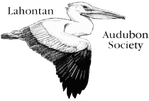|
By Rose Strickland Pinyon Jay volunteers with Lahontan Audubon Society (LAS) were not surprised when an environmental group filed a petition on April 25, 2022, with the U.S. Fish and Wildlife Service (USFWS) to list the Pinyon Jay under the Endangered Species Act. Rumors had been circulating for many months that the Pinyon Jay populations and habitat were continuing to decline and needed concerted conservation and protection actions to reverse the declines. Pinyon Jays are the most gregarious of jay species, gathering most of the year in noisy flocks of a few to hundreds of birds, foraging for pine nuts in pinyon pine woodlands and open pinyon-juniper and sagebrush habitat, and roosting in safe areas. Ranging all over the west, the jays are more concentrated in northern New Mexico and in the Great Basin Desert in Nevada. Like the Sage Grouse, Pinyon Jay flocks were common and little studied until the alarming 80% declines in populations and in habitats were revealed in decades of breeding bird survey data. Partners in Flight estimates there are only 210,000 Pinyon Jays left in Nevada, which now makes up about 27.5% of the global population. In 2021, in response to these alarming declines, LAS partnered with Great Basin Bird Observatory (GBBO) to set up a Pinyon Jay Community Science survey project so that community scientists can help monitor Pinyon Jay populations and gather important information on habitat uses. GBBO scientists set up a process for volunteers, using an app (Survey123) on their cell phones, to report the presence or absence of Pinyon Jays. Survey123 includes a form for reporting data on the number of jays seen, different behaviors, and photographs of surrounding habitat. Volunteers are being recruited and trained on how to use Survey123 in a series of monthly field trips to local habitat sites, scheduled by LAS. LAS volunteers have been surveying for Pinyon Jay flocks in western Nevada since early this year with good results. Three breeding flocks have been identified so far - in the Carson Range west of Reno, in the Pine Nut Mountains east of Carson City and, surprisingly, on Peavine Mountain, north of Somersett. Interestingly, the Carson Range and Peavine Mountain sites have very few to no pinyon pine habitat. Instead, the Pinyon Jays are nesting in areas with tall Ponderosa or Jeffrey pine trees which produce pine nuts most years. This summer while the jays are bringing up their young, volunteers are also scouting several areas for good jay survey sites when flocking re-occurs in the fall. GBBO set up a Pinyon Jay Community Science Hub to collect Pinyon Jay data from Nevada and other western states. An interactive map shows where and when pinyon jay data was collected and how many jays were counted - see: https://pinyon-jay-community-science-gbbo.hub.arcgis.com/pages/results. LAS volunteers will continue to collect data on Pinyon Jays in our local area while the wheels of government turn. The USFWS has 90 days to decide whether the petition includes substantial information that may warrant listing of the Pinyon Jay. If the agency accepts the petition, it will initiate a status review, including a call for data on the species' population, trends, distribution, and the threats to Pinyon Jay populations and habitats. Based on this information, the USFWS will determine if listing is warranted, not warranted, or warranted but precluded by other pending listing proposals for higher priority species. The Lahontan Audubon Society will submit the data collected by our volunteers as part of the listing process. In the meantime, our volunteers will expand their surveys into areas reported to have large wintering jay flocks. Some areas to scout are Petersen Mountain and the juniper woodlands farther north of Swan Lake, additional areas in the Carson Range west of Reno and Carson City, wooded areas around Minden and Gardnerville, and, despite the wildfires, surviving woodland habitat patches around Woodfords and Markleeville. Because pinyon pine nut production can be variable from year to year, GBBO is interested in getting more information on the productivity of pinyon pines in these areas. Areas where pinyon pines are loaded with cones could be prioritized for Pinyon Jay surveys. Lahontan Audubon Society is concerned about the loss of Pinyon Jay habitat in pinyon-juniper woodland removal projects by the Bureau of Land Management and the U.S. Forest Service intended to improve habitat for Sage Grouse and for other management objectives. Are these vegetation treatment projects affecting woodland-dependent species like Pinyon Jays? Better habitat management for Pinyon Jays would assess the impacts of tree removal projects in critical Pinyon Jay habitats, such as nesting, roosting or foraging woodland areas. Monitoring data collected through community science can help fill the data gaps where information to identify and protect Pinyon Jay critical habitat areas is lacking. What can we all do to help this iconic bird of the West survive? Join the Pinyon Jay volunteers to collect data on which habitats are most critical for Pinyon Jays to nest, forage, and cache pine nuts. You can use this link to fill out a volunteer interest form for the Lahontan Audubon Pinyon Jay survey project: https://www.nevadaaudubon.org/volunteer.html. Click on the Conservation Committee and Pinyon Jay Surveys in the drop down menu on the form. You will be contacted with information on how to download and use the app and how to start your own community science hub account. Whether you’re hiking or biking your favorite mountain trails, hunting, fishing, camping in the woods, or birding your favorite hot spots for fall migrants or Great Basin resident birds, you can report your jay sightings to the Community Science hub to help prioritize which areas to conserve and protect for our Pinyon Jays. |
topics
All
Archives
July 2024
|


 RSS Feed
RSS Feed